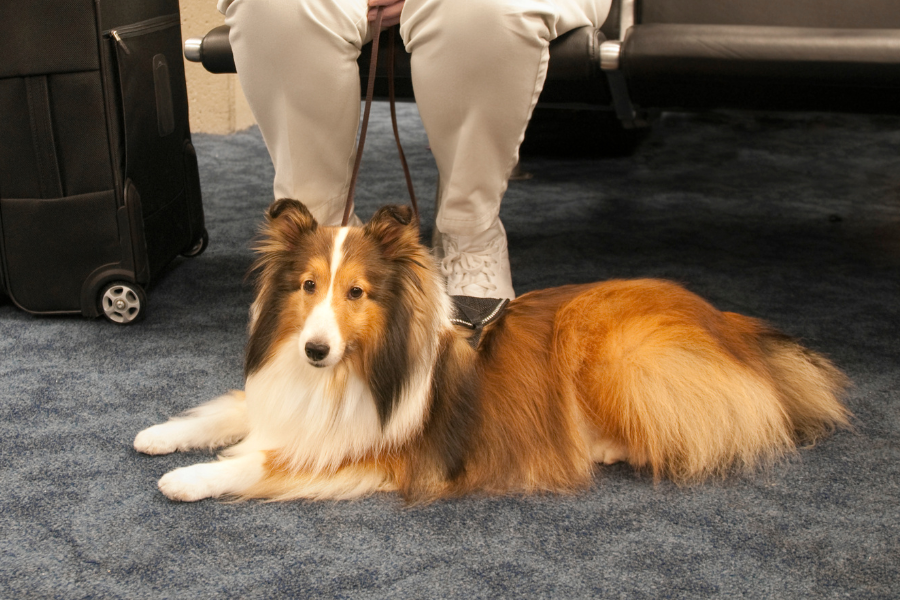
Travel ESA Letter: What It Is, What It Isn’t, and What You Actually Need to Fly with Your Dog
- Published on:
- By: ASP Team
If you’ve been searching for a travel ESA letter, you’re not alone. Many pet owners hope their emotional support animals can fly with them in the cabin — but airline policies have changed dramatically in recent years.
As a result, there’s widespread misunderstanding about what documentation is truly valid when it comes to flying with your dog. While ESA letters are still useful in housing situations, they no longer guarantee travel privileges.
This article clears up the confusion, explains what a travel ESA letter can and cannot do, and outlines how you can qualify for legitimate access through a Psychiatric Service Animal (PSA) instead. If you’re looking to fly with your dog and avoid surprises at the gate, this guide will help you do it the right way.
Understanding the Confusion Around a Travel ESA Letter
Many people search for a “travel ESA letter” hoping to bring their emotional support animal on a flight. However, this phrase is often misunderstood.
As of recent airline policy changes, most major U.S. carriers no longer accept ESA letters for in-cabin travel. What’s actually required is documentation for a Psychiatric Service Animal (PSA) — not an ESA — including proof of task training.
So while the phrase “travel ESA letter” is common in online searches, travelers need to be informed that an ESA letter alone will not grant in-cabin access for flights.
Instead, if you have a mental health condition that qualifies under the ADA, and your dog has been trained to perform specific tasks to assist you, then you may qualify for PSA access — with proper documentation.
ESA vs PSA: What’s the Difference?
It’s super important to understand the difference between these two:
- Emotional Support Animals (ESA) are awesome companions that offer comfort just by being there, but they haven’t been specifically trained to perform tasks.
- Psychiatric Service Animals (PSA) are different—they’re specially trained to do things like help you through a panic attack, gently remind you about medication, or even guide you when you’re feeling disoriented.
While ESAs get some protections for housing, they don’t have the same public access rights, especially when it comes to flying. PSAs, on the other hand, are covered by the Air Carrier Access Act (ACAA)—as long as you can show that you need them and that your furry friend is properly trained.
Get Your ESA Today
Can You Still Fly with a Dog Using a Travel ESA Letter?
Honestly, probably not anymore. Airlines have totally changed their rules to match the new Department of Transportation (DOT) guidelines. So, what do you need instead?
- You’ll need a DOT Service Animal Air Transportation Form. This basically confirms your furry friend is trained to help you with your disability.
- Also, get a real letter or document that proves your diagnosis and that your PSA (Psychiatric Service Animal) is legitimate.
Just a “travel ESA letter” won’t cut it. Airlines can actually say no to boarding if your animal isn’t trained to perform specific tasks.
How American Service Pets Can Help
ESA letters are still important, especially for housing. But if you’re experiencing mental health conditions that make daily life challenging, you might qualify for a Psychiatric Service Animal (PSA) evaluation and supporting documentation.
At American Service Pets, our licensed professionals are here to help. They’ll assess if a Psychiatric Service Dog is right for you and guide you through getting the documentation needed, including what airlines require.
Ready to see if you qualify for a PSA letter? Start your qualification process here.
Why the Shift Away from ESAs on Planes?
The policy change regarding Emotional Support Animals (ESAs) on flights arose from widespread complaints by airlines and passengers concerning the misuse of ESA privileges, including untrained animals and safety risks.
In response, the U.S. Department of Transportation reclassified ESAs as pets in 2021, removing their prior in-cabin travel allowances.
Now, only service dogs trained to assist individuals with mental or physical disabilities are permitted to fly free of charge in the cabin. ESAs can still travel, but they are subject to standard pet regulations, including applicable fees, crate requirements, and cargo policies.
When Is an ESA Letter Still Useful?
While a travel ESA letter isn’t accepted for flights anymore, it can still be incredibly useful for other important situations:
- For your home life (under the Fair Housing Act): Good news! Landlords are generally required to make reasonable accommodations for your emotional support animal if you have a valid letter.
- For students: Many universities and colleges are still happy to accept ESA letters for on-campus housing or dorms.
- For your well-being: Having an official ESA letter from a licensed provider can help acknowledge your animal’s vital role in your mental health journey, and can even be useful in therapy discussions.
Just a friendly reminder, though: this doesn’t extend to air travel anymore.
Qualifying for a PSA Letter: What’s Required?
Flying with a psychiatric service dog can be life-changing, but there are a few steps you need to take to ensure a smooth journey. Here’s what you’ll need:
- A diagnosed mental health condition like PTSD, anxiety, panic disorder, or depression.
- A task-trained dog that helps you manage your condition.
- The right paperwork, including:
- The DOT Air Travel Form
- Behavior attestation form required by some airlines
- A recommendation letter from a licensed professional—American Service Pets can help with this!
Don’t forget: Your pup needs to be well-behaved, house-trained, and calm in busy spaces like airports and airplane cabins. With these boxes checked, you can focus on your journey while your service dog has your back.
Common Myths About Travel ESA Letters
Let’s clear up some of the most common misconceptions:
Myth 1: Any ESA letter will get my dog on a plane.
❌ False. ESAs are no longer recognized for flight privileges.
Myth 2: I can just say my dog is a PSA.
❌ Airlines require documentation, and they can deny travel for false claims.
Myth 3: My small dog in a purse counts as an ESA.
❌ Size doesn’t determine classification. Only task-trained PSAs are allowed for in-cabin access.
Myth 4: My ESA letter from years ago is still valid for flying.
❌ No. Airlines have changed their rules, and only service animals are recognized.
Travel Tips for PSA Handlers
If you’re planning to fly with your PSA, follow these steps:
- Contact the airline at least 48 hours in advance. Submit all required forms.
- Bring backup documents. Even if not required, it’s helpful to have your training and diagnosis paperwork.
- Use a labeled harness or vest. Not required by law, but helps reduce confusion.
- Be ready for questions. Airline staff may ask about what tasks your dog is trained to perform, though they cannot ask about your diagnosis.
Frequently Asked Questions
Can I use a travel ESA letter to fly with my emotional support dog?
No. Since the 2021 change in DOT regulations, airlines are no longer required to accept ESA letters for air travel. Only trained psychiatric service dogs qualify for in-cabin access under the Air Carrier Access Act. A “travel ESA letter” is a misleading term — what you actually need is documentation for a PSA.
How do I know if I qualify for a PSA?
To qualify, you must have a documented mental health condition such as PTSD, anxiety, depression, or panic disorder, and your dog must be trained to perform specific tasks related to that condition. You can start your evaluation process through a trusted provider like American Service Pets.
What if my dog is very small and well-behaved?
Even a calm and tiny dog cannot qualify for PSA status without task training. Airline staff may allow pets in the cabin in a carrier, but this comes with fees and restrictions. If you’re looking for free in-cabin access without a carrier, you must go through the PSA route.
Is my ESA letter still good for anything?
Yes. While a travel ESA letter is no longer accepted by airlines, it still qualifies your pet for housing rights under the Fair Housing Act. With a valid ESA letter, landlords cannot charge pet fees or impose breed/size restrictions.
Where can I start if I think I need a PSA instead of an ESA?
If you’re unsure whether you qualify or what steps to take, a good first step is taking our short qualification quiz. After this, our licensed professionals can evaluate your condition and help you determine whether a PSA letter is appropriate for your needs.
Final Takeaway: Travel ESA Letter vs. What You Actually Need
Many people search for “travel ESA letter,” but it’s important to understand current airline regulations. Emotional support animal (ESA) letters alone are no longer sufficient for air travel. However, individuals can still fly with a properly trained and documented psychiatric service dog, which meets the updated requirements.
At American Service Pets, we assist eligible individuals in obtaining evaluations and proper documentation to comply with airline policies. Our team ensures that your needs are recognized and that you have the necessary support to travel with confidence and peace of mind.

The benefits of an Emotional Support Animal certification and a Psychiatric Service Dog certification are drastically different. Fortunately for you, American Service Pets’ network of active board certified doctor or other licensed mental health providers can help you find the right path to certification. To find out whether you need an ESA or PSD letter, take our easy, three-step Pet Owner Survey!
More Great Resources





